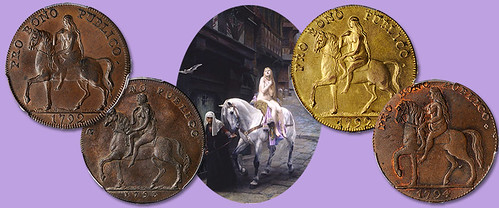
PREV ARTICLE
NEXT ARTICLE
FULL ISSUE
PREV FULL ISSUE
LADY GODIVA AND THE TOKENS OF COVENTRYOn his Stack's Bowers blog this week Jeremy Bostwick published an article about Lady Godiva and the trade tokens of Coventry. -Editor  Possibly better known now due to her association with a brand of chocolates, the Lady Godiva in Anglo-Saxon days was a noblewoman married to Leofric, the Earl of Mercia in what is now central England. Though the legend surrounding her is viewed today rather apocryphally, it nevertheless has survived for at least seven centuries at least in part because of its risqué nature. The story dates to the 13th century, while Godiva herself (Godgifu in Old English) floruit around the time of the Norman invasion in 1066. Sympathetic toward the citizens of Coventry as a result of the burdens of taxation levied by her husband, she beseeched him repeatedly to cease with his oppressive taxes, with each entreaty being quashed. Finally, having grown weary of Godiva's many requests, Leofric acquiesced, stating that he would grant her wish solely on the condition that she would strip naked and ride a horse through the streets of Coventry. Taking him at his word, she did just that, clad only in her long hair that, in the world of art, is often "strategically" used to cloth her. Upon her agreement to the proposal, Leofric issued a commandment that the townsfolk look away and remain indoors, lest they see his wife's unclothed state. All but one—a man named Thomas—obeyed this order. Poor Thomas, having caught an illicit glimpse at the naked countess, was allegedly struck blind. From this tale, the notion of a "peeping Tom" originated and persists in the vernacular to this day. The legendary "naked ride" is still celebrated widely in Coventry, with numerous references in the form of monuments, art, and a festival. An unclothed female upon a horse is even on the city's flag and coat-of-arms. It is clear that, despite its rather dubious origin, the tale is treated as a civic badge of honor. In numismatics, this is abundantly clear, with numerous late-18th century Coventry trade tokens employing this popular iconography. On these pieces, Lady Godiva is presented riding left upon a horse, seated sidesaddle toward the viewer and modestly attempted to cover herself. Our upcoming Collectors Choice Online (CCO) auction in February will offer a charming selection of these "Lady Godiva" tokens, presenting different years, reverse types, and artistic renditions of the countess. Though it is more likely that this event did not occur, it is rather fitting that the ride—for which the alleged purpose was the lowering of taxes to aid the local economy—eventually made its way onto a form of token specie meant to alleviate the current coining shortage and facilitate the commerce of not just Coventry, but of the United Kingdom as a whole. To read the complete article, see:
 Wayne Homren, Editor The Numismatic Bibliomania Society is a non-profit organization promoting numismatic literature. See our web site at coinbooks.org. To submit items for publication in The E-Sylum, write to the Editor at this address: whomren@gmail.com To subscribe go to: https://my.binhost.com/lists/listinfo/esylum All Rights Reserved. NBS Home Page Contact the NBS webmaster 
|